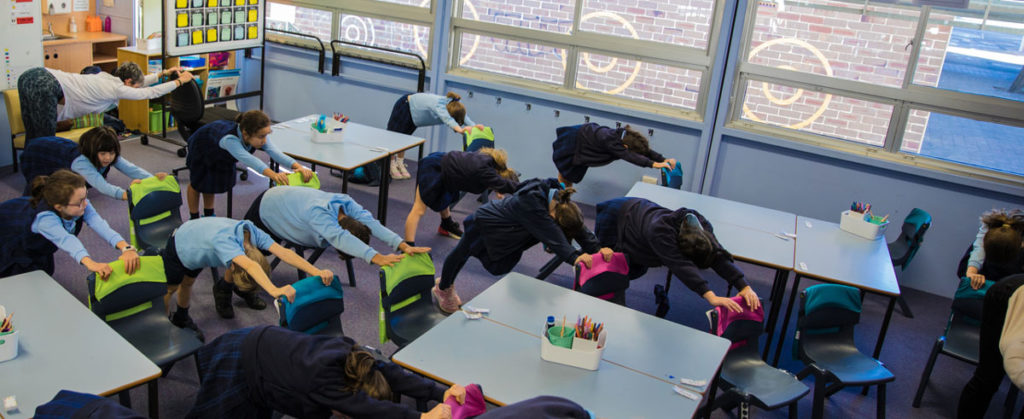Changes that need to happen in the next 10 years for a mindful classroom

We now accept the fact that learning is a lifelong process of keeping abreast of change.
And the most pressing task is to teach people how to learn.
Peter Drucker
Education departments worldwide have done super well – in fact, to date, they’ve achieved an A+ in teaching content. Teachers have been ‘fountains of knowledge’ filling their students, like empty vessels, with information. Schools have been efficient in teaching students how to write well, listen well, remember well and regurgitate pretty well too.
All that has worked in the past… what about the future?
Moving deeper into the 21st century, this paradigm is shifting. There are other skills - skills that extend beyond content, computers and technology - that will be necessary to succeed in life, and the workforce.
Research agrees that collaboration and teamwork, creativity and imagination, critical thinking and problem solving are skills that must be developed and harnessed.
To make it in the world, students will need to learn the art of empathy and resilience, becoming global citizens and lifelong learners. They will need to show initiative, be ethical, socially responsible and technologically literate. The need for oral and written communication skills goes without saying.
What classroom changes must happen in the next 10 years to ensure our children will be well rounded, competent and healthy humans?
1. The role of the teacher must shift from one of ‘fountain’ to one of facilitator – someone who asks good questions, questions that stimulate debate and reasoning and cultivate life skills.
2. The classroom environment will need to change from one that is linear with minimal distraction to one that is more organic - perhaps with sliding panels and instead of desks in rows, modular furniture to be arranged as best needed - areas for group work, discussion, research and debate. The ‘outside’ will be allowed inside – computers, tablets, phones – as they provide access to an infinite world of knowledge.
3. Off-site Learning: learning will take place more outside the classroom through research, reading and video. The new classroom will be a place where content is debated and discussed.
4. Learning goals must change from simply memorising and regurgitating content to ones that nurture creative and critical thinking. Students are not empty vessels, but come into the classroom, each with a unique history and body of knowledge. This knowledge must be honoured and appreciated. Current research has identified many new forms of intelligence, which also must all be appreciated and nourished in the classroom. Testing and systems of evaluation will need to keep up with these new understandings.
And, in my opinion, the most important element, given the high burnout rate amongst teachers and the exponential rise of mental health issues amongst our children (often as young as 3) is:
5. Student and Teacher Mental Health and Wellbeing: How do we create future fit classrooms where nourished teachers nurture students to become capable, creative, critical thinkers while maintaining their mental health and wellbeing? How do we create inclusive learning environments where students build resilience, are empathic citizens of the classroom who care about one another, the environment, their community and the world at large – who are kind and compassionate to themselves and others?
It's easier than you think! Weaving mindful movement (yoga), breathwork and mindfulness into every school day, for just minutes at a time, is a low cost and highly effective way to create calmer, healthier and more vibrant learning environments. And teachers don’t need to be health gurus either, they just need a few simple tools.
Why is this SO important?
Because just a few minutes of mindful movement and deep breathing overrides the stress response, halting the flight-fight hormone production. Strengthening, lengthening, twisting, bending and stretching, coupled with smooth breaths, creates mental and physical focus which immediately helps students and teachers to feel vibrant, interested and able to concentrate better and for longer, and be far less reactive. Mindfulness practices stimulate kindness to oneself and to others. The parasympathetic arm of the nervous system (rest and digest) kicks in, triggering the relaxation response, a term coined in the 1970s by Dr Herbert Benson, professor, author, cardiologist and founder of Harvard’s Mind/Body Medical Institute.
In a world that is chaotic and over-stimulating for all of us, especially kids, it’s important to offer what I call Peace Pauses – minutes where students and teachers are drawn back into the present… to re-set.
Academic knowledge is paramount, but no less so is the mental health and wellbeing of our teachers and students. Creating future fit schools means creating environments where students are nurtured into whole human beings – healthy, creative and critical thinkers and learners; self aware; and kind, compassionate citizens of the classroom, their community and the world.
Beth Borowsky is an educator, yoga teacher, teacher trainer and mum of 2 adult daughters. She is the founder of JustBreatheYoga (www.justbreatheyoga.com.au) and The Karma Class (www.thekarmaclass.com ) Her accredited workshop A Karma Classroom: Yoga, Breath + Mindfulness teaches Australian teachers how to implement culture change within their classrooms and school by easily weaving minutes of daily Yoga, Breath and Mindfulness into the day.
